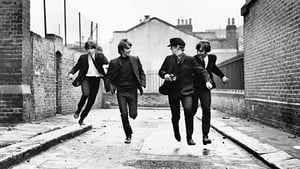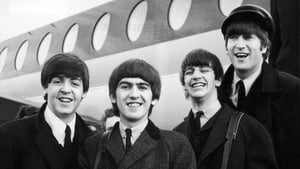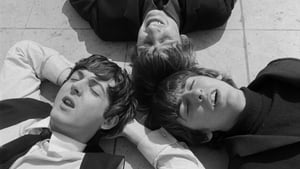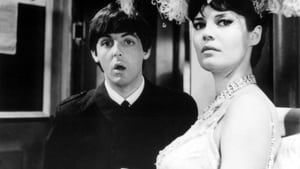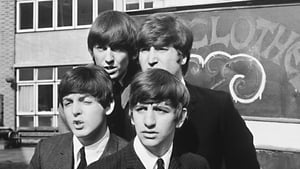Contact: info@alwanfilm.com
Video Sources 0 Views

Synopsis
Review: A Hard Day’s Night 1964 Colorized – The Beatles’ Cinematic Revolution

Introduction
Few films in the history of cinema capture the zeitgeist of an era as perfectly as A Hard Day’s Night (1964). Directed by Richard Lester and starring the most famous band in the world, The Beatles, this film is more than just a rock-and-roll musical; it’s a cultural milestone that encapsulates the energy, charm, and irreverence of the 1960s. Released during the height of Beatlemania, A Hard Day’s Night has been lauded for its innovative style, witty humor, and the unforgettable performances of John Lennon, Paul McCartney, George Harrison, and Ringo Starr. In this article, we will delve into the making of A Hard Day’s Night, explore its plot and characters, and discuss its lasting impact on both cinema and popular culture.
Check The Full Colorized Movies List
Check Our Colorized Movies Trailer Channel
Understanding A Hard Day’s Night 1964 Colorized: Director, Cast, and Genre
A Hard Day’s Night was directed by Richard Lester, a relatively unknown filmmaker at the time, whose previous work in television and short films demonstrated a flair for quick-paced, surreal comedy. Lester’s vision for A Hard Day’s Night was groundbreaking; he wanted to create a film that was as dynamic and unpredictable as The Beatles themselves. The movie blurs the line between documentary and fiction, presenting a day in the life of The Beatles as they navigate the chaos of fame, the demands of their career, and their own playful antics.
The cast of A Hard Day’s Night is, of course, led by The Beatles, who play fictionalized versions of themselves. John Lennon, Paul McCartney, George Harrison, and Ringo Starr, with their natural charisma and chemistry, turned what could have been a routine promotional vehicle into a vibrant and enduring work of art. Supporting them are a cast of talented character actors, including Wilfrid Brambell as Paul’s mischievous grandfather, Norman Rossington as their harried manager, and Victor Spinetti as the increasingly frantic television director. The film’s genre is often categorized as a musical comedy, but it defies easy classification. It is at once a satire of the music industry, a celebration of youth culture, and an avant-garde experiment in filmmaking.
Exploring the World of A Hard Day’s Night 1964 Colorized: Plot and Characters
The plot of A Hard Day’s Night is deceptively simple: it follows The Beatles over the course of 36 hours as they prepare for a television performance. The film opens with the band being chased by hordes of screaming fans through the streets of London, setting the tone for the fast-paced, madcap adventure that follows. Along the way, the boys deal with a series of humorous and absurd situations, from escaping their minders to evading reporters, all while trying to keep Paul’s troublemaking grandfather out of mischief.
Each of The Beatles has their own distinct persona in the film, which is consistent with how they were perceived by the public. John is the witty, sarcastic one; Paul is the charming, slightly mischievous one; George is the quiet, contemplative one; and Ringo is the lovable, slightly forlorn underdog. While the film doesn’t delve deeply into their personal lives or relationships, it does offer a glimpse into the camaraderie and genuine friendship that made The Beatles such a phenomenon.
The characters they interact with are just as memorable, from the exasperated TV producer who can’t control the chaos surrounding the band, to Paul’s grandfather, who is described as a “clean old man” but proves to be anything but, stirring up trouble wherever he goes. These interactions provide much of the film’s humor and charm, making A Hard Day’s Night not just a showcase for The Beatles’ music, but a genuinely entertaining narrative in its own right.
The Art of Film Editing in A Hard Day’s Night 1964 Colorized
One of the most remarkable aspects of A Hard Day’s Night is its innovative editing, which was crucial in defining the film’s energetic and anarchic style. Richard Lester and editor John Jympson used a rapid-cutting technique that was ahead of its time, giving the film a kinetic energy that mirrored the frenzied pace of Beatlemania. The editing is especially notable in the musical sequences, where the quick cuts, unconventional angles, and syncopated rhythms create a visual representation of The Beatles’ music.
This style of editing, which was influenced by the French New Wave, was groundbreaking in 1964 and has since become a staple of music videos and commercials. The way A Hard Day’s Night seamlessly blends the musical performances with the narrative scenes was revolutionary, helping to blur the lines between reality and fiction, and allowing the audience to feel as though they were part of The Beatles’ world. The editing also contributed to the film’s sense of spontaneity and unpredictability, making it feel like a living, breathing entity rather than a static piece of cinema.
The Cultural Impact of A Hard Day’s Night 1964 Colorized
A Hard Day’s Night was more than just a film; it was a cultural event that captured the spirit of the 1960s. Released at the height of Beatlemania, the film was an instant hit, drawing massive crowds to theaters around the world. It provided fans with an unprecedented glimpse into the lives of their idols, while also introducing The Beatles to a wider audience who might not have been familiar with their music.
The film’s influence extended far beyond its initial release. It set the template for the modern music video, with its innovative use of editing, camera work, and visual storytelling. The film’s style has been imitated and referenced in countless other films, television shows, and commercials, solidifying its place as one of the most influential films of all time.
A Hard Day’s Night also played a crucial role in establishing The Beatles as cultural icons. It showcased their wit, charm, and musical talent in a way that transcended mere pop stardom, helping to cement their status as the most important band of the 20th century. The film’s success also proved that The Beatles were not just a musical phenomenon, but a cultural one, capable of influencing not just music, but film, fashion, and the very fabric of popular culture.
The Music of A Hard Day’s Night 1964 Colorized: A Soundtrack for the Ages
Of course, no discussion of A Hard Day’s Night would be complete without mentioning the music. The film’s soundtrack is one of The Beatles’ most beloved, featuring classic songs like “A Hard Day’s Night,” “Can’t Buy Me Love,” “I Should Have Known Better,” and “If I Fell.” These songs, many of which were written specifically for the film, showcase The Beatles at the height of their creative powers, blending infectious melodies with sophisticated lyrics and innovative arrangements.
The music in A Hard Day’s Night is more than just a soundtrack; it’s an integral part of the film’s narrative and emotional impact. Each song is perfectly matched to the scenes in which it appears, whether it’s the exuberant joy of “Can’t Buy Me Love” as the boys frolic in a field, or the tender longing of “If I Fell” as they prepare for their performance. The music elevates the film, turning what could have been a simple promotional vehicle into a work of art that stands on its own.
The film also helped to redefine the role of music in cinema. Before A Hard Day’s Night, musicals were often seen as separate from the narrative, with the songs serving as interludes or breaks from the action. But in A Hard Day’s Night, the music is seamlessly integrated into the film, driving the story forward and enhancing the emotional resonance of each scene. This approach has since become standard in music-driven films, but it was groundbreaking in 1964.
The Legacy of A Hard Day’s Night 1964 Colorized
The legacy of A Hard Day’s Night is immense, both in terms of its impact on cinema and its role in shaping the cultural landscape of the 1960s. The film’s innovative style, quick-witted humor, and infectious energy have made it a timeless classic that continues to be celebrated by new generations of fans.
One of the most significant aspects of the film’s legacy is its influence on the music video genre. The quick-cut editing, dynamic camera work, and playful visual style of A Hard Day’s Night set the template for the modern music video, which emerged as a dominant form of visual expression in the 1980s. Directors like Michel Gondry, Spike Jonze, and David Fincher have all cited A Hard Day’s Night as a major influence on their work, and its impact can be seen in countless music videos, commercials, and films.
The film also had a profound impact on the way pop music and popular culture were perceived. Before A Hard Day’s Night, rock-and-roll films were often dismissed as lowbrow entertainment, designed solely to capitalize on the popularity of the musicians involved. But A Hard Day’s Night proved that a pop music film could be both artistically significant and commercially successful, paving the way for future rock films like Tommy (1975), Purple Rain (1984), and This Is Spinal Tap (1984).
Moreover, A Hard Day’s Night played a key role in elevating The Beatles to the status of cultural icons. By showcasing their wit, charm, and musical talent, the film helped to establish them as more than just a pop band, but as a cultural phenomenon that would go on to influence music, fashion, film, and society as a whole. The Beatles’ influence on popular culture is immeasurable, and A Hard Day’s Night was a crucial step in their journey to becoming the most important band of the 20th century.
Reception and Critical Acclaim of A Hard Day’s Night 1964 Colorized
When A Hard Day’s Night was released in 1964, it was met with widespread acclaim from both critics and audiences. The film’s innovative style, infectious energy, and irreverent humor were praised, and it quickly became a box office hit. Critics lauded the film for its fresh approach to the rock-and-roll movie genre, with many noting that it transcended the typical fare of the time.
The film’s success was not limited to the UK; it was also a major hit in the United States, where it introduced The Beatles to an even larger audience. American critics were particularly impressed by the film’s wit and style, with many comparing it to the work of French New Wave directors like Jean-Luc Godard. The film’s impact on American cinema was immediate, influencing a new generation of filmmakers and helping to usher in a more experimental, freewheeling approach to filmmaking.
Over the years, A Hard Day’s Night has only grown in stature, with many critics and filmmakers citing it as one of the greatest films of all time. In 1999, the British Film Institute ranked it as the 88th greatest British film of the 20th century, and in 2010, Time magazine included it in its list of the 100 greatest films of all time. The film’s legacy continues to be celebrated, with new generations discovering its timeless appeal and enduring relevance.
Where to Watch A Hard Day’s Night 1964 Colorized Online
For those looking to experience the magic of A Hard Day’s Night, the film is widely available on various streaming platforms. It can be found on services like Amazon Prime Video, iTunes, and Criterion Channel, where it is available for rent or purchase in both standard and high-definition formats. Additionally, the film has been released on Blu-ray and DVD, with various editions offering special features like behind-the-scenes documentaries, interviews with the cast and crew, and restored audio and video quality.
FAQs About A Hard Day’s Night 1964 Colorized
Q: Was A Hard Day’s Night scripted or improvised?
A: While much of the dialogue in A Hard Day’s Night feels spontaneous, the film was actually carefully scripted by screenwriter Alun Owen. However, Richard Lester encouraged The Beatles to ad-lib and bring their own personalities to their roles, which contributed to the film’s loose, improvisational feel.
Q: How did A Hard Day’s Night influence the music video industry?
A: The innovative editing, dynamic camera work, and seamless integration of music in A Hard Day’s Night set the template for the modern music video. The film’s style was highly influential in the development of the music video industry, which emerged in the 1980s as a dominant form of visual expression in popular music.
Q: What is the significance of the title A Hard Day’s Night?
A: The title A Hard Day’s Night comes from a malapropism by Ringo Starr, who described a particularly long day of filming as “a hard day’s night.” The phrase captured the film’s playful, irreverent spirit and was chosen as the title of both the film and its accompanying soundtrack.
Conclusion
In conclusion, A Hard Day’s Night is much more than just a film; it is a cultural artifact that captures the essence of the 1960s and the phenomenon that was The Beatles. With its innovative style, infectious energy, and timeless music, the film remains a landmark in the history of cinema, influencing generations of filmmakers and musicians alike. Whether you’re a lifelong Beatles fan or a newcomer to their music, A Hard Day’s Night is an essential viewing experience that continues to inspire and entertain audiences around the world. As we reflect on the enduring legacy of this cinematic gem, it’s clear that A Hard Day’s Night will remain a vital part of our cultural consciousness for many years to come.

